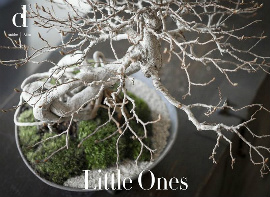Little Ones by Prairie Stuart-Wolff
Posted on July 3, 2014 within News
 A budding bonsai artist
A budding bonsai artist
On the brink of his twenties, Takuya Shimazu stumbled upon the world of bonsai and quickly dedicated himself to the craft. Largely self-taught, he works outside the vocation’s more staid traditions. His pieces reflect a certain whimsy, and Shimazu’s enthusiasm for bonsai is as apparent as it is infectious. Here is his story …
I planted this little guy from a seedling about eleven years ago. Pine tends to grow vertically straight. I train the young trunks with wire and gently shape them over time. The fibers and the bark adapt to the wire. That’s the crux of bonsai: shaping trees. So in that way, what I’m doing is traditional. But in terms of style, my approach isn’t. My bonsai tend to look lanky or frail compared to traditional bonsai. But in my view, there is no mandate on how bonsai should look. Each tree has its own character. I try to understand that character in order to enhance it.
Pine is the traditional symbol of bonsai. Among the trees, it’s the most delicate and is therefore highly prized. It requires a lot of attention to care. Other kinds of trees and plants are more forgiving. If pine dries out, it cannot be revived but if tended to, pine can live for centuries. Those who follow the formal concept of bonsai regard pine as the only true bonsai. I respect that view, but I also question it, as there is a wonderful variety of bonsai plants to choose from.
By Prairie Stuart-Wolff
This is the fifth in a continuing series of featured articles authored by Prairie Stuart-Wolff from her online publication Cultivated Days.









